I was fortunate to play Meadowbrook Country Club recently as part of an outing. While I grew up close to the course and my family lives even closer now, it was never a course that I had heard much about nor one that I had much interest in seeing. That all changed a few years ago with a renovation by Andy Staples, who turned the course from a standard American tree-lined country club course to an open one with bold features heavily influenced by MacDonald/Raynor design principles and style of shaping. With the pictures that I had been seeing over the past few years, Meadowbrook moved pretty much right to the top of courses that I wanted to see in my home state.
Despite some reservations that I’ll discuss in detail when I get to the relevant holes, Staples and co. have done an outstanding job here. There’s a level of thought put into the design of these holes that’s uncommon, even among the top new courses. There’s a lot of care in this work. The course has excellent balance from tee-to-green, with some easier driving holes and some tougher ones, and complements some (to put it mildly) unreceptive greens with more receptive ones. Bunkers are very thoughtfully placed and not excessive, unlike some other top new courses. The internal green contours are simply outstanding.
I think it’s also important to commend the club for its boldness with this redesign. Although I never played the previous version, I’ve seen pictures and the transformation is just remarkable. And risky. They must have sunk millions of dollars into this renovation. Their course must have been closed for the better part of at least two seasons. I’m sure that the decision was controversial and difficult because you never quite know how well people will react to the changes. You could lose a lot of members and the promise of new ones might not materialize.
Fortunately from what I heard, the risks have paid off. There’s a waiting list for membership as the new course has generated extraordinary buzz. The course immediately started making lists of the best courses in the state and there’s a strong argument to make that’s it’s placed too low on some of them (especially Golf Digest). So the future looks pretty bright for Meadowbrook Country Club.
So let’s discuss the golf course. The short par 4 first is a fine start. It shouldn’t be too difficult if you play the proper conservative drive to avoid the bunker ~225 out on the left. It gets more difficult if you try to get further down the fairway, which narrows and has a tree on the right. The approach is uphill to a green which slopes pretty good from back-to-front and most of whose surface is obscured by bunkers.
Despite some reservations that I’ll discuss in detail when I get to the relevant holes, Staples and co. have done an outstanding job here. There’s a level of thought put into the design of these holes that’s uncommon, even among the top new courses. There’s a lot of care in this work. The course has excellent balance from tee-to-green, with some easier driving holes and some tougher ones, and complements some (to put it mildly) unreceptive greens with more receptive ones. Bunkers are very thoughtfully placed and not excessive, unlike some other top new courses. The internal green contours are simply outstanding.
I think it’s also important to commend the club for its boldness with this redesign. Although I never played the previous version, I’ve seen pictures and the transformation is just remarkable. And risky. They must have sunk millions of dollars into this renovation. Their course must have been closed for the better part of at least two seasons. I’m sure that the decision was controversial and difficult because you never quite know how well people will react to the changes. You could lose a lot of members and the promise of new ones might not materialize.
Fortunately from what I heard, the risks have paid off. There’s a waiting list for membership as the new course has generated extraordinary buzz. The course immediately started making lists of the best courses in the state and there’s a strong argument to make that’s it’s placed too low on some of them (especially Golf Digest). So the future looks pretty bright for Meadowbrook Country Club.
So let’s discuss the golf course. The short par 4 first is a fine start. It shouldn’t be too difficult if you play the proper conservative drive to avoid the bunker ~225 out on the left. It gets more difficult if you try to get further down the fairway, which narrows and has a tree on the right. The approach is uphill to a green which slopes pretty good from back-to-front and most of whose surface is obscured by bunkers.
The second hole is an excellent par 5 that follows the property line. It’s possible for many to carry the fairway bunker but you need to be careful about how close you cut the left side as the out-of-bounds is tight there (and I saw at least a handful of balls cross it).
It’s a very tough layup if you can’t reach the green. Two bunkers pinch the layup zone from around 100 yards. The green has a very steep false front and I saw more than one ball roll off the front (this will become a theme…). But it’s also quite large and the hole provides opportunities if you approach it sensibly.
The third is one of the holes for which the new Meadowbrook has received a lot of attention. Again, there’s only one fairway bunker and it’s pretty easy for a good player to carry.
But the main event here is the green, which is one of the most unusual that I’ve seen. It’s sort-of an upside-down L shape, for which the hook of the L is a bowl with four sideboards. This is one of the most receptive hole locations that I’ve seen anywhere, although it’s small and you probably won’t be able to see its bottom. While pin placements in the front-left shouldn’t be too difficult, the back left is tricky because it’s narrow and if you miss right, it’s a really tough putt out of the bowl. I think that this might actually be my favorite hole location because the shot from the bowl is playable and there’s a safe miss to the front-left of the green.
I’m not a huge fan of the angularity of some of the shaping or the flat tier of fairway-height grass at the front-right, but it’s a very thoughtful green complex and very interesting.
I’m not a huge fan of the angularity of some of the shaping or the flat tier of fairway-height grass at the front-right, but it’s a very thoughtful green complex and very interesting.
The par 5 fourth was one of my favorites on the course. There’s plenty of room off the tee although trying to shave off the left side can result in tree trouble. Whether laying up or going for the green, the second shot is outstanding. There’s a bunker in the middle of the fairway a few dozen yards short of the green. Laying up short and left of the bunker should leave a flat lie, but also leaves a poor angle to a green that runs away. Getting past the bunker on the right opens the view and allows you to play more into the contours of the green.
The best scenario is if you can get your ball just short-right of the green because the green edge is quite mild here. Like many of the greens, this one is convex (slopes off) on the edges and most of these edges are quite severe—a bit too severe for my tastes. If you miss short or left, there’s a good chance that the next shot is coming back to your feet or going over the other side. Approaching from short and right helps a lot here.
The long, dogleg right par 4 fifth has gotten a lot of attention for its punchbowl green. Now my main complaint about Meadowbrook, which I’ve already started with on the last hole, is that there are several greens with multiple severe edges that make it easy to miss the green on your chip. But as I mentioned in my intro, the course is well-balanced and several greens, like the third and this one, are more receptive. I’m not a huge fan of this green because I’m not a fan of the abrupt shaping at its edges. But the receptiveness of the green balances the difficult of the hole from tee-to-green. So artistic quibbles aside, it’s a very good hole.
The mid-length par 3 sixth looks pretty severe and it is if you go at the middle of the green and can’t put a lot of spin on the ball. The runoffs long and short are steep and fairly long. But there’s another possibility—the area right of the green kicks balls onto the green. Although you can’t really tell from the tee, there’s a lot of short grass over there and if you can’t hold the green on the direct line, it’s a sensible way to play the hole. Not obviously, but certainly something that you’d learn to use after repeat plays.
It’s probably not an obvious pick, but the short par 4 seventh was one of my favorite holes. Although the pond presents a real challenge for shorter hitters, the fairway looks wide open and a bit mundane for everyone else. Why even mess will the bunkers on the left?
Because the green is narrow, very undulating, and angled in this direction. The left side is also the only place where you might have a decent view of it. It’s very difficult to approach the green from the right rough (the right side of the fairway kicks right) and while the visibility is better the closer that you are to the green, the high right shoulder makes for a very awkward short shot. The green has some of the best internal contours of any and I thought that this was a great hole.
Because the green is narrow, very undulating, and angled in this direction. The left side is also the only place where you might have a decent view of it. It’s very difficult to approach the green from the right rough (the right side of the fairway kicks right) and while the visibility is better the closer that you are to the green, the high right shoulder makes for a very awkward short shot. The green has some of the best internal contours of any and I thought that this was a great hole.
I found the green complex on the mid-length par 3 eighth to be a bit too severe. There’s a steep falls front and you want no part of what’s over the green (although it’s an interesting variety of impossible shots). The smart play is to the middle of the green which will put you in decent shape for a pin anywhere on the right side but will still leave a very difficult putt to anywhere on the left. There are too many disasters if you aim at a left pin and miss (although there is a backstop for a front-left pin) so just aim to the middle and do the best that you can with the putter.
Nine is a short par 4 with another severe green complex. It’s a very good driving hole, with two bunkers up the right that you can try to carry based on your ability. While being a bit more to the left allows you to play into the deepest aspect of the green, the green is so narrow and the edges around the entire front so steep that there isn’t a whole lot of safety in the perfectly placed layup. But it’s also very difficult to hit the green from anywhere near the green.
I think that the safest play is to play to the back-center, where there’s a pretty good backstop. This will be a very unsatisfying play if the pin is in the front and will leave a very tough putt but it’s easy to make a 6 if you aim at the front of the green from almost anywhere unless you’re about a +2 handicap or better.
I think that the safest play is to play to the back-center, where there’s a pretty good backstop. This will be a very unsatisfying play if the pin is in the front and will leave a very tough putt but it’s easy to make a 6 if you aim at the front of the green from almost anywhere unless you’re about a +2 handicap or better.
Most good golfers should be able to carry the right fairway bunker at about 230 yards (except me). That’s probably the best play here because it gives you a much clearer view of another undulating green. This one feeds to the back-right. A noteworthy feature of this hole is the beautiful elm tree short-left of the green.
Eleven is a fantastic downhill par 3. The green is very deep but the right side is very undulating, featuring a little dip in the right-center that runs off the green. There’s plenty of open space and short grass to the right of the green, but you’d better have a pretty good short game if you’re over there.
I think that it’d be reasonable to call the par 5 twelfth hole the most relaxed hole from tee-to-green on the course, but it’s none the worse for it. There’s a moderate task in carrying the left fairway bunker but the approach is straightforward and there’s no trouble in front of the green.
As we’ve seen on many other holes, the green is a bit less relaxed than the rest of the hole. There’s a false front here, but it’s only severe on the left side. Most of the green is pretty receptive and like at the fourth, if you’re approaching from the right, it’s not too hard. But if the pin is front-left, be careful…I saw more than one person putt off the green to that hole location.
Looking at my photos, I’m reminded that when I first stood on the par 3 thirteenth tee, I thought that the fourth green was the the thirteenth! The actual thirteenth green is in the right side of the frame. It’s a much easier shot than that to the fourth green would be! Long is dead, but the green is pretty wide and receptive.
There are a few interesting aspects to the short par 4 fourteenth, the first being its uphill drive over a big ridge. The architect/shapers have helpfully cut a gap through the middle which provides a nice aiming point and gives shorter hitters and chance to get up the hill. That gives you a better chance of seeing the green, which is pretty important here. It horseshoes around a bunker at its front-center. Just as important is the ridge running across the middle of the green. It can help contain shots played to the front of the green but makes for very difficult putting if going front to back/vice versa.
The long, gently doglegging right par 4 fifteenth was another of my favorite holes, due in part to its relative simplicity. By that, I don’t mean that it’s an easy hole—if you bail out away from the right bunkers, it can be a long, awkward approach. But the green complex is large and the edges (except at the front-left) are either softer or have rough on them, which stops the ball from running too far away. The green is open in front, which helps with the long, running shot that you’ll likely have.
Sixteen is pretty straightforward. I think the main thing here is that the further you drive it, the better view of the green that you’ll have. This green is quite large and the edges aren’t too severe—another nice case of the balance that I mentioned at the outset. It also has some of the finest subtle contours of all of them.
With several large oaks and maples at its edges, the drive on the par 5 seventeenth is the most traditional country-club-looking shot on the course. The green, however, is anything but: it sits at the back of a massive biarritz pad that starts with two bunkers about 60 yards short of the green. The biarritz swale forms a false front for the actual green surface, which has another sharp runoff at its left. I’ve never been a huge fan of the abruptness of biarritz swales on other courses and this green, with a particularly steep-and-deep one and sharp runoffs right and left, is a bit much for me. As on 4 or 5 other greens, I would have preferred some softer contours at the edges here.
The final hole is a bit easier off the tee than it looks. Good players should be able to carry the right bunker easily and if you do that, you should be able to run it pretty far down the fairway. The green is different in character than the others, sitting on the lay of the land at its back and only moderately built up in front. I suspect that this green, which is on the site of its predecessor, is also most similar to its predecessor. I thought that the softer edges around this green were a nice change of pace and I liked it—although it’s still very difficult, with pretty good back-to-front slope and a trough in the middle.
I think that Meadowbrook is easily one of the ten best courses in the state of Michigan and possibly one of its top 5. While they haven’t yet, I suspect that the rankings will catch up with it soon. There’s so much that’s interesting here. While its architectural roots appear to be in the MacDonald/Raynor style, it doesn’t have the standard template holes (the biarritz is on a par 5) so it has a strong sense of originality. The green contours are as interesting as you could want. It’s very thoughtful from tee-to-green without going overboard on the bunkering…something that its northern Michigan stylistic counterpart the South Course at Arcadia Bluffs unfortunately does. Because of its greater variety and sense of balance (and better land), I prefer Meadowbrook.
As I’ve mentioned a few times however, I had two issues with some of the greens, one more aesthetic and one functional. I didn’t love the look of the sharp ridges and hollows around a lot of these greens. The property is hilly, but there’s no part of it that’s really abrupt. The slopes are mostly gradual. I thought the abruptness of a lot of the shaping was a bit inconsistent with the character of the property. I don’t mind shaping like this, but I think that it’d bit in a bit better on a site that’s flatter (like Arcadia Bluffs—South) or had abrupt features like these…like the rock outcroppings you find in Westchester County, NY or near the Appalachians.
But this is really a matter of personal taste and while I personally hold it against the course a little bit, I can understand not holding it against the course at all. A bigger issue I think is the severity of the edges of some of the greens from a functional perspective. Some of these greens are very difficult to hit and leave you little place to miss from which you’ll have a straightforward next shot. I think that it’d help if some of the greens had been built a little bit lower and the slopes off them were more gradual and longer (this would also address my first criticism) because then a shot that just runs to the edge of the green runs a few feet off rather than down a steep hill into a very difficult spot. Wild shots would still be penalized because they would run far away from the green but shots that are a little bit off would be punished far less.
As I mentioned though, not all of the greens are like this. At least half-a-dozen are very receptive and you might argue that that’s enough to give people a chance to make up for some of the grief caused by the others. As with the rest of the layout, there’s still pretty good balance across the green complexes. But I think that a lot of the interest in what the architect/shapers were trying to go for around the edges of the greens could have been accomplished with softer slopes.
I suppose that the best thing that you can say about Meadowbrook is that it stimulates a lot of thinking. It’s a course that you want to play over in your mind because there are so many interesting details and it’s difficult to know what to think of them as you play them, especially if you only play once. This course is the reason why I like to take pictures of courses: when someone puts this kind of thought into a place, the pictures can help you remember some small detail that you forgot about, but that helps make a hole. I’d love to have the chance to see it again some day.
As I’ve mentioned a few times however, I had two issues with some of the greens, one more aesthetic and one functional. I didn’t love the look of the sharp ridges and hollows around a lot of these greens. The property is hilly, but there’s no part of it that’s really abrupt. The slopes are mostly gradual. I thought the abruptness of a lot of the shaping was a bit inconsistent with the character of the property. I don’t mind shaping like this, but I think that it’d bit in a bit better on a site that’s flatter (like Arcadia Bluffs—South) or had abrupt features like these…like the rock outcroppings you find in Westchester County, NY or near the Appalachians.
But this is really a matter of personal taste and while I personally hold it against the course a little bit, I can understand not holding it against the course at all. A bigger issue I think is the severity of the edges of some of the greens from a functional perspective. Some of these greens are very difficult to hit and leave you little place to miss from which you’ll have a straightforward next shot. I think that it’d help if some of the greens had been built a little bit lower and the slopes off them were more gradual and longer (this would also address my first criticism) because then a shot that just runs to the edge of the green runs a few feet off rather than down a steep hill into a very difficult spot. Wild shots would still be penalized because they would run far away from the green but shots that are a little bit off would be punished far less.
As I mentioned though, not all of the greens are like this. At least half-a-dozen are very receptive and you might argue that that’s enough to give people a chance to make up for some of the grief caused by the others. As with the rest of the layout, there’s still pretty good balance across the green complexes. But I think that a lot of the interest in what the architect/shapers were trying to go for around the edges of the greens could have been accomplished with softer slopes.
I suppose that the best thing that you can say about Meadowbrook is that it stimulates a lot of thinking. It’s a course that you want to play over in your mind because there are so many interesting details and it’s difficult to know what to think of them as you play them, especially if you only play once. This course is the reason why I like to take pictures of courses: when someone puts this kind of thought into a place, the pictures can help you remember some small detail that you forgot about, but that helps make a hole. I’d love to have the chance to see it again some day.

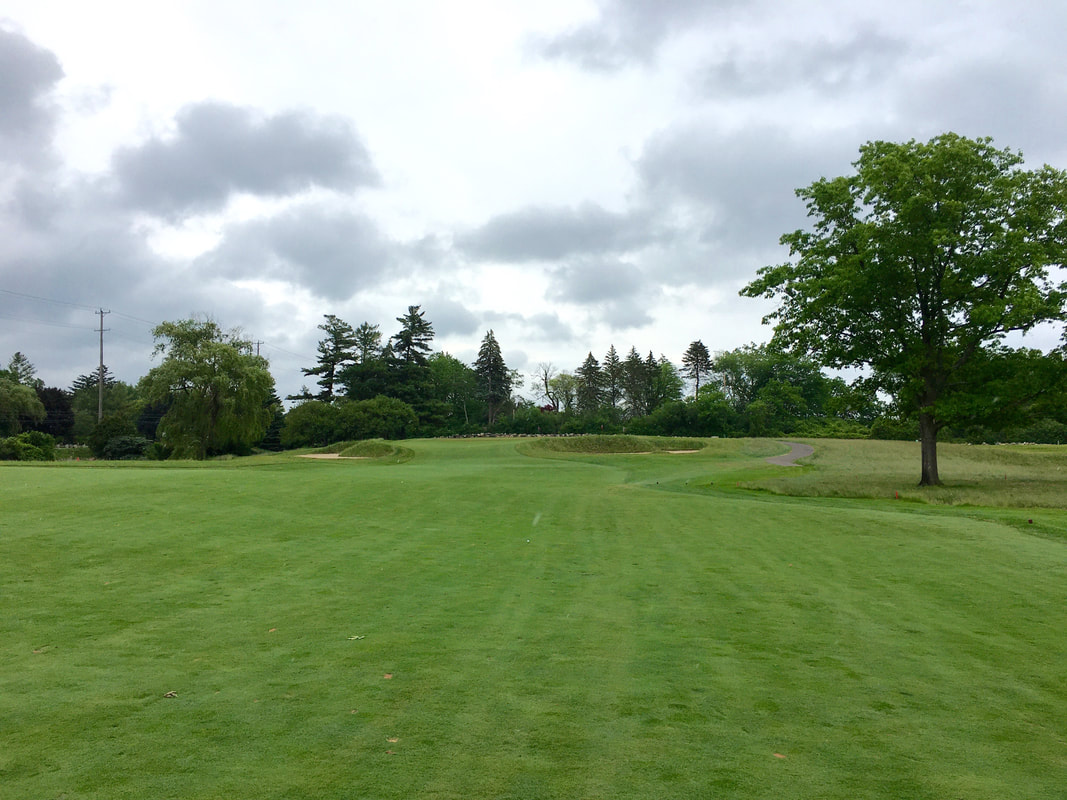



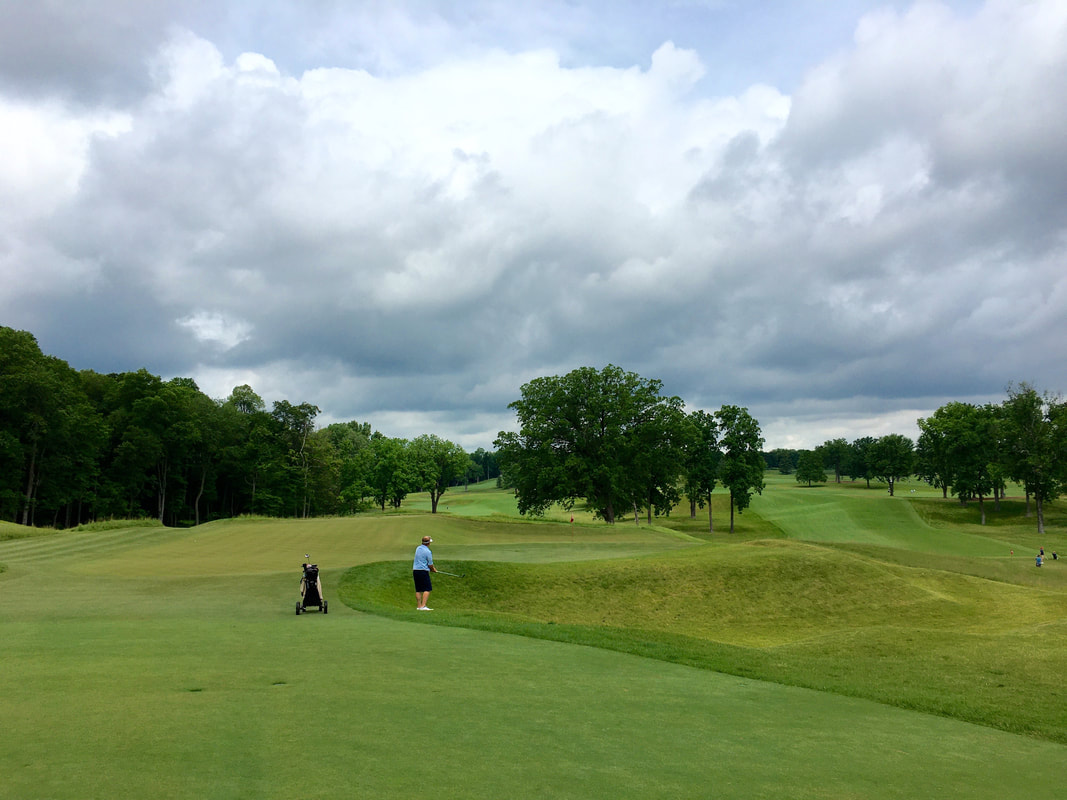














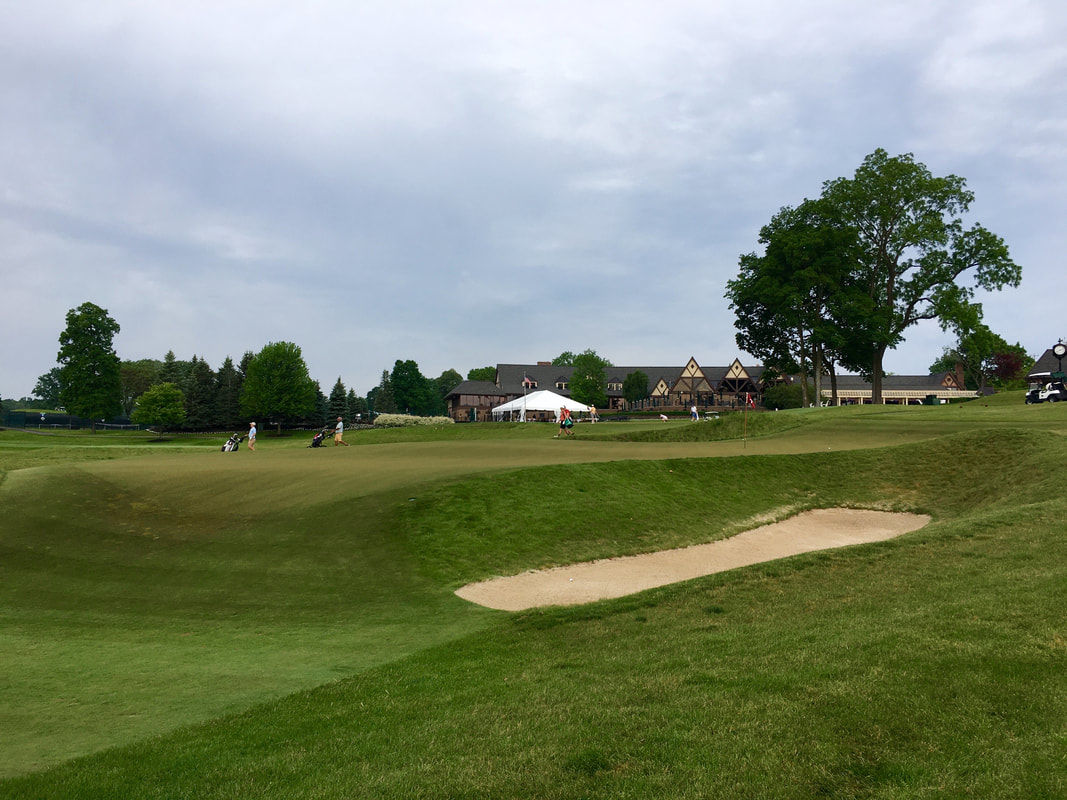









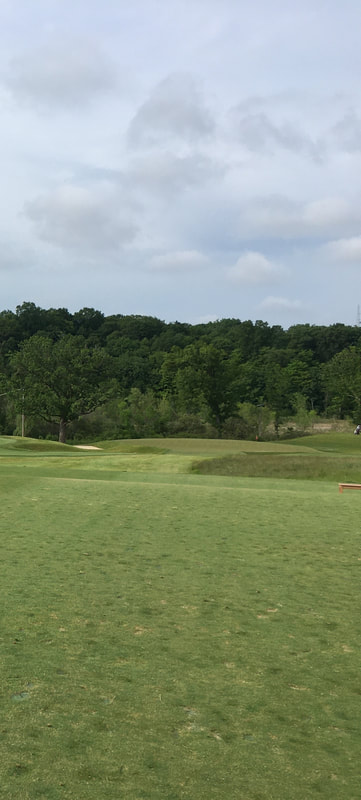







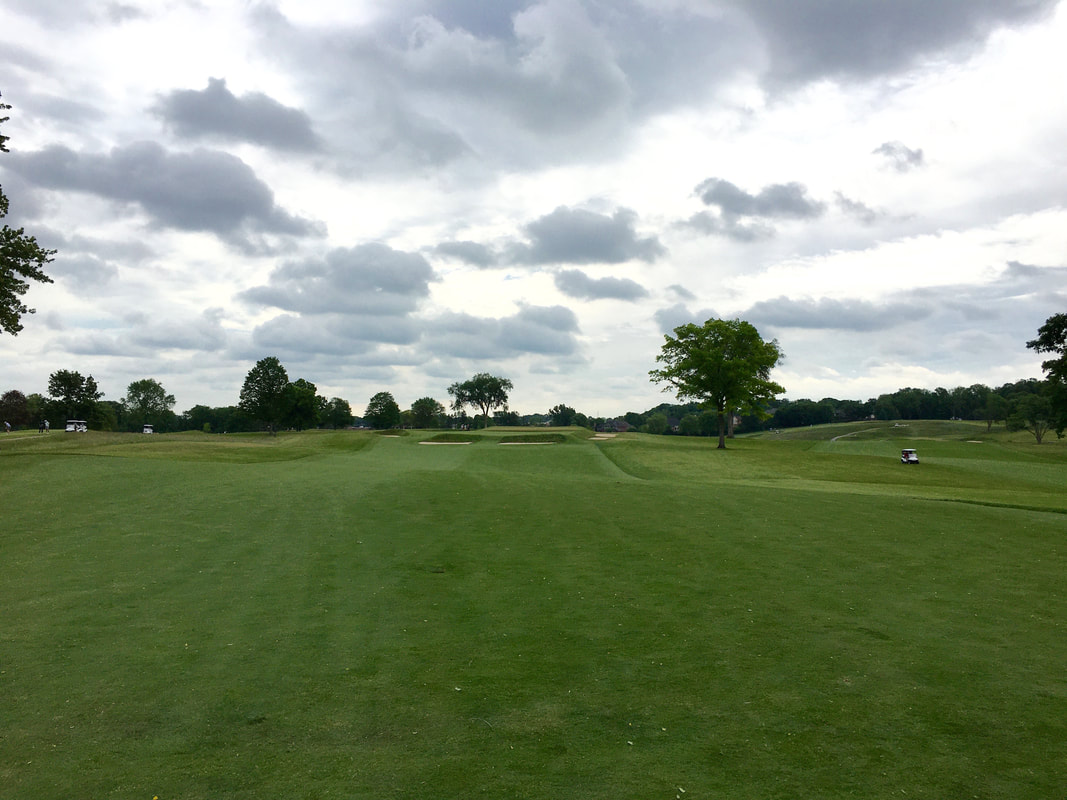




 RSS Feed
RSS Feed